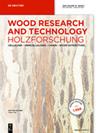Impact of a conditioning step during the treatment of wood with melamine-formaldehyde resin on dimensional stabilisation
IF 1.6
3区 农林科学
Q2 FORESTRY
引用次数: 0
Abstract
The dimensional stabilisation of wood using thermosetting resins relies on the resin uptake into the cell walls. This study tested if a conditioning step after the impregnation and before the final heat-curing enhances the cell wall uptake to improve dimensional stabilisation without increasing the chemical consumption. Small blocks of Scots pine sapwood were vacuum-impregnated with an aqueous melamine formaldehyde solution and conditioned at 33, 70, or 95 % RH for up to 1 week before drying and curing the blocks at 103 °C. However, the conditioning step decreased the cell wall bulking and the moisture exclusion effect compared to the immediate heat curing of the impregnated samples. Analyses of the resin-treated samples by scanning electron microscopy, IR spectroscopy and confocal Raman microspectroscopy provided evidence of wood hydrolysis and polycondensation of the resin within the cell lumen during the conditioning step. Hydrolysis and removal of wood constituents may have counterbalanced the cell wall bulking of the resin. Polycondensation of the resin in the lumen increased its molecule size, which could have hindered the cell wall diffusion of the resin.三聚氰胺甲醛树脂处理木材过程中一个调节步骤对尺寸稳定性的影响
使用热固性树脂的木材的尺寸稳定性依赖于树脂进入细胞壁。本研究测试了浸渍后和最终热固化前的调理步骤是否能增强细胞壁的吸收,从而在不增加化学消耗的情况下提高尺寸稳定性。用三聚氰胺甲醛水溶液真空浸渍苏格兰松材的小块,并在33、70或95% RH条件下干燥1周,然后在103°C下干燥和固化。然而,与浸渍样品的直接热固化相比,调理步骤降低了细胞壁膨胀和排湿效果。通过扫描电子显微镜、红外光谱和共聚焦拉曼显微光谱对树脂处理过的样品进行分析,发现在调节步骤中,树脂在细胞腔内发生了木材水解和缩聚。水解和木材成分的去除可能抵消了树脂的细胞壁膨胀。树脂在腔内的缩聚增加了其分子大小,这可能阻碍了树脂的细胞壁扩散。
本文章由计算机程序翻译,如有差异,请以英文原文为准。
求助全文
约1分钟内获得全文
求助全文
来源期刊

Holzforschung
工程技术-材料科学:纸与木材
CiteScore
4.60
自引率
4.20%
发文量
83
审稿时长
3.3 months
期刊介绍:
Holzforschung is an international scholarly journal that publishes cutting-edge research on the biology, chemistry, physics and technology of wood and wood components. High quality papers about biotechnology and tree genetics are also welcome. Rated year after year as one of the top scientific journals in the category of Pulp and Paper (ISI Journal Citation Index), Holzforschung represents innovative, high quality basic and applied research. The German title reflects the journal''s origins in a long scientific tradition, but all articles are published in English to stimulate and promote cooperation between experts all over the world. Ahead-of-print publishing ensures fastest possible knowledge transfer.
 求助内容:
求助内容: 应助结果提醒方式:
应助结果提醒方式:


